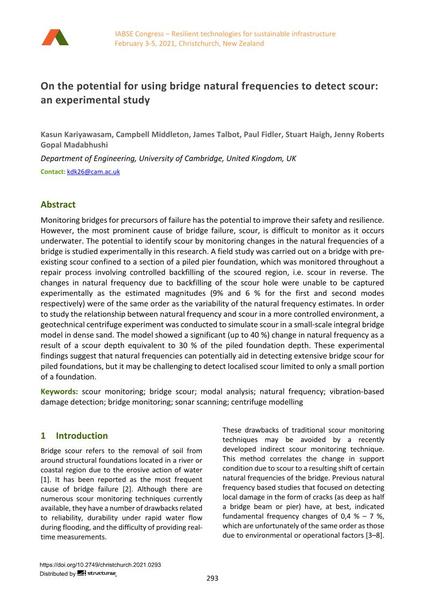On the potential for using bridge natural frequencies to detect scour: an experimental study

|
|
|||||||||||
Bibliografische Angaben
| Autor(en): |
Kasun Kariyawasam
(Department of Engineering, University of Cambridge, United Kingdom, UK)
Campbell Middleton (Department of Engineering, University of Cambridge, United Kingdom, UK) James Talbot (Department of Engineering, University of Cambridge, United Kingdom, UK) Paul Fidler (Department of Engineering, University of Cambridge, United Kingdom, UK) Stuart Haigh (Department of Engineering, University of Cambridge, United Kingdom, UK) Jenny Roberts (Department of Engineering, University of Cambridge, United Kingdom, UK) Gopal Madabhushi (Department of Engineering, University of Cambridge, United Kingdom, UK) |
||||
|---|---|---|---|---|---|
| Medium: | Tagungsbeitrag | ||||
| Sprache(n): | Englisch | ||||
| Tagung: | IABSE Congress: Resilient technologies for sustainable infrastructure, Christchurch, New Zealand, 3-5 February 2021 | ||||
| Veröffentlicht in: | IABSE Congress Christchurch 2020 | ||||
|
|||||
| Seite(n): | 293-301 | ||||
| Anzahl der Seiten (im PDF): | 9 | ||||
| DOI: | 10.2749/christchurch.2021.0293 | ||||
| Abstrakt: |
Monitoring bridges for precursors of failure has the potential to improve their safety and resilience. However, the most prominent cause of bridge failure, scour, is difficult to monitor as it occurs underwater. The potential to identify scour by monitoring changes in the natural frequencies of a bridge is studied experimentally in this research. A field study was carried out on a bridge with pre- existing scour confined to a section of a piled pier foundation, which was monitored throughout a repair process involving controlled backfilling of the scoured region, i.e. scour in reverse. The changes in natural frequency due to backfilling of the scour hole were unable to be captured experimentally as the estimated magnitudes (9% and 6 % for the first and second modes respectively) were of the same order as the variability of the natural frequency estimates. In order to study the relationship between natural frequency and scour in a more controlled environment, a geotechnical centrifuge experiment was conducted to simulate scour in a small-scale integral bridge model in dense sand. The model showed a significant (up to 40 %) change in natural frequency as a result of a scour depth equivalent to 30 % of the piled foundation depth. These experimental findings suggest that natural frequencies can potentially aid in detecting extensive bridge scour for piled foundations, but it may be challenging to detect localised scour limited to only a small portion of a foundation. |
||||
| Stichwörter: |
Eigenfrequenz Modalanalyse Brückenmonitoring
|
||||
